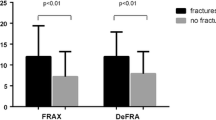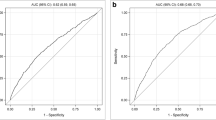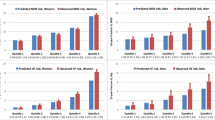Abstract
Summary
This study reports that both FRAX and Garvan calculators underestimated fractures in Australian men and women, particularly in those with osteopenia or osteoporosis. Major osteoporotic fractures were poorly predicted, while both calculators performed acceptably well for hip fractures.
Introduction
This study assessed the ability of the FRAX (Australia) and Garvan calculators to predict fractures in Australian women and men.
Methods
Women (n = 809) and men (n = 821) aged 50–90 years, enrolled in the Geelong Osteoporosis Study, were included. Fracture risk was estimated using FRAX and Garvan calculators with and without femoral neck bone mineral density (BMD) (FRAXBMD, FRAXnoBMD, GarvanBMD, GarvannoBMD). Incident major osteoporotic (MOF), fragility, and hip fractures over the following 10 years were verified radiologically. Differences between observed and predicted numbers of fractures were assessed using a chi-squared test. Diagnostics indexes were calculated.
Results
In women, 115 MOF, 184 fragility, and 42 hip fractures occurred. For men, there were 73, 109, and 17 fractures, respectively. FRAX underestimated MOFs, regardless of sex or inclusion of BMD. FRAX accurately predicted hip fractures, except in women with BMD (20 predicted, p = 0.004). Garvan underestimated fragility fractures except in men using BMD (88 predicted, p = 0.109). Garvan accurately predicted hip fractures except for women without BMD (12 predicted, p < 0.001). Fractures were underestimated primarily in the osteopenia and osteoporosis groups; MOFs in the normal BMD group were only underestimated by FRAXBMD and fragility fractures by GarvannoBMD, both in men. AUROCs were not different between scores with and without BMD, except for fragility fractures predicted by Garvan in women (0.696, 95% CI 0.652–0.739 and 0.668, 0.623–0.712, respectively, p = 0.008) and men, which almost reached significance (0.683, 0.631–0.734, and 0.667, 0.615–0.719, respectively, p = 0.051). Analyses of sensitivity and specificity showed overall that MOFs and fragility fractures were poorly predicted by both FRAX and Garvan, while hip fractures were acceptably predicted.
Conclusions
Overall, the FRAX and Garvan calculators underestimated MOF and fragility fractures, particularly in individuals with osteopenia or osteoporosis. Hip fractures were predicted better by both calculators. AUROC analyses suggest that GarvanBMD performed better than GarvannoBMD for prediction of fragility fractures.
Similar content being viewed by others
References
Cooper C (1993) Epidemiology and public health impact of osteoporosis. Baillieres Clin Rheumatol 7:459–477. https://doi.org/10.1016/S0950-3579(05)80073-1
Pasco JA, Henry MJ, Korn S, Nicholson GC, Kotowicz MA (2009) Morphometric vertebral fractures of the lower thoracic and lumbar spine, physical function and quality of life in men. Osteoporos Int 20:787–792. https://doi.org/10.1007/s00198-008-0744-6
Otmar R, Kotowicz MA, Brennan SL, Bucki-Smith G, Korn S, Pasco JA (2013) Personal and psychosocial impacts of clinical fracture in men. J Mens Health 10:22–27
Pasco JA, Sanders KM, Hoekstra FM, Henry MJ, Nicholson GC, Kotowicz MA (2005) The human cost of fracture. Osteoporos Int 16:2046–2052
Cummings SR, Melton LJ (2002) Epidemiology and outcomes of osteoporotic fractures. Lancet 359:1761–1767. https://doi.org/10.1016/S0140-6736(02)08657-9
Sanders KM, Nicholson GC, Watts JJ, Pasco JA, Henry MJ, Kotowicz MA, Seeman E (2006) Half the burden of fragility fractures in the community occur in women without osteoporosis. When is fracture prevention cost-effective? Bone 38:694–700
Reid IR, Horne AM, Mihov B, Stewart A, Garratt E, Wong S, Wiessing KR, Bolland MJ, Bastin S, Gamble GD (2018) Fracture prevention with Zoledronate in older women with osteopenia. N Engl J Med 379:2407–2416. https://doi.org/10.1056/NEJMoa1808082
Kanis JA (2008) FRAX™ and the assessment of fracture probability in men and women from the UK. Osteoporos Int 19:385–397
University of Sheffield UK (2011) FRAX ® WHO Fracture Risk Assessment Tool. http://www.shef.ac.uk/FRAX/
Bauer DC (2011) FRAX, falls, and fracture prediction: predicting the future. Arch Intern Med 171:1661–1662
Cosman F, de Beur SJ, LeBoff MS, Lewiecki EM, Tanner B, Randall S, Lindsay R, National Osteoporosis Foundation (2014) Clinician’s guide to prevention and treatment of osteoporosis. Osteoporos Int 25:2359–2381. https://doi.org/10.1007/s00198-014-2794-2
Nguyen ND, Frost SA, Center JR et al (2008) Development of prognostic nomograms for individualizing 5-year and 10-year fracture risks. Osteoporos Int 19:1431–1444. https://doi.org/10.1007/s00198-008-0588-0
Nguyen ND, Frost SA, Center JR, et al (2007) Development of a nomogram for individualizing hip fracture risk in men and women. Osteoporos Int 18:1109–1117. https://doi.org/10.1007/s00198-007-0362-8
Henry MJ, Pasco JA, Merriman EN, Zhang Y, Sanders KM, Kotowicz MA, Nicholson GC (2011) Fracture risk score and absolute risk of fracture. Radiology 259:495–501. https://doi.org/10.1148/radiol.10101406
Bolland MJ, Siu ATY, Mason BH, Horne AM, Ames RW, Grey AB, Gamble GD, Reid IR (2011) Evaluation of the FRAX and Garvan fracture risk calculators in older women. J Bone Miner Res 26:420–427. https://doi.org/10.1002/jbmr.215
Sandhu S, Nguyen N, Center J, et al (2010) Prognosis of fracture: evaluation of predictive accuracy of the FRAX algorithm and Garvan nomogram. Osteoporos Int 21:863–871. https://doi.org/10.1007/s00198-010-1527-4
Czerwinski E, Kanis JA, Osieleniec J, Kumorek A, Milert A, Johansson H, McCloskey EV, Gorkiewicz M (2011) Evaluation of FRAX to characterise fracture risk in Poland. Osteoporos Int 22:2507–2512. https://doi.org/10.1007/s00198-010-1502-0
Kanis JA, Oden A, Johansson H, McCloskey E (2012) Pitfalls in the external validation of FRAX. Osteoporos Int 23:423–431. https://doi.org/10.1007/s00198-011-1846-0
Azagra R, Roca G, Encabo G, Aguyé A, Zwart M, Güell S, Puchol N, Gene E, Casado E, Sancho P, Solà S, Torán P, Iglesias M, Gisbert MC, López-Expósito F, Pujol-Salud J, Fernandez-Hermida Y, Puente A, Rosàs M, Bou V, Antón JJ, Lansdberg G, Martín-Sánchez JC, Díez-Pérez A, Prieto-Alhambra D (2012) FRAX® tool, the WHO algorithm to predict osteoporotic fractures: the first analysis of its discriminative and predictive ability in the Spanish FRIDEX cohort. BMC Musculoskelet Disord 13:204. https://doi.org/10.1186/1471-2474-13-204
González-Macías J, Marin F, Vila J, Díez-Pérez A (2012) Probability of fractures predicted by FRAX® and observed incidence in the Spanish ECOSAP study cohort. Bone 50:373–377. https://doi.org/10.1016/j.bone.2011.11.006
Pasco JA, Nicholson GC, Kotowicz MA (2012) Cohort profile: Geelong osteoporosis study. Int J Epidemiol 41:1565–1575
Pasco JA, Nicholson GC, Henry MJ et al (1999) Identification of incident fractures: the Geelong osteoporosis study. Aust NZ J Med 29:203–206
Genant HK, Wu CY, van Kuijk C, Nevitt MC (1993) Vertebral fracture assessment using a semiquantitative technique. J Bone Miner Res 8:1137–1148. https://doi.org/10.1002/jbmr.5650080915
Giles GG, Ireland PD (1996) Dietary questionnaire for epidemiological studies (version 2). Melbourne, Cancer Counc Victoria
Henry MJ, Pasco JA, Korn S, Gibson JE, Kotowicz MA, Nicholson GC (2010) Bone mineral density reference ranges for Australian men: Geelong osteoporosis study. Osteoporos Int 21:909–917
Henry MJ, Pasco JA, Pocock NA, Nicholson GC, Kotowicz MA (2004) Reference ranges for bone densitometers adopted Australia-wide: Geelong osteoporosis study. Australas Radiol 48:473–475
Swets JA (1988) Measuring the accuracy of diagnostic systems. Science 240:1285–1293
DeLong ER, DeLong DM, Clarke-Pearson DL (1988) Comparing the areas under two or more correlated receiver operating characteristic curves: a nonparametric approach. Biometrics 44:837–845
Garvan Institute of Medical Research (2008) Bone Fracture Risk Calculator. https://www.garvan.org.au/promotions/bone-fracture-risk/calculator/index.php. Accessed 8 May 2019
Kanis JA, Hans D, Cooper C et al (2011) Interpretation and use of FRAX in clinical practice. Osteoporos Int 22:2395–2411
Holloway KL, Kotowicz MA, Lane SE, Brennan SL, Pasco JA (2015) FRAX (Aus) and falls risk: association in men and women. Bone 76:1–4. https://doi.org/10.1016/j.bone.2015.03.004
Cooley H, Jones G (2001) A population-based study of fracture incidence in southern Tasmania: lifetime fracture risk and evidence for geographic variations within the same country. Osteoporos Int 12:124–130
Crandall CJ, Larson J, LaCroix A, Cauley JA, LeBoff MS, Li W, LeBlanc ES, Edwards BJ, Manson JAE, Ensrud K (2019) Predicting fracture risk in younger postmenopausal women: comparison of the Garvan and FRAX risk calculators in the Women’s health initiative study. J Gen Intern Med 34:235–242
Sornay-Rendu E, Munoz F, Delmas PD, Chapurlat RD (2010) The FRAX tool in French women: how well does it describe the real incidence of fracture in the OFELY cohort. J Bone Miner Res 25:2101–2107. https://doi.org/10.1002/jbmr.106
Sanders KM, Stuart AL, Scott D, Kotowicz MA, Nicholson GC (2015) Validity of 12-month falls recall in community-dwelling older women participating in a clinical trial. Int J Endocrinol 2015:210527. https://doi.org/10.1155/2015/210527
Acknowledgments
We thank the Australian Institute for Health and Welfare (AIHW) for providing deaths data.
Funding
This study is supported by the National Health and Medical Research Council (NHMRC) of Australia (251638, 299831, 628582), the Geelong Regional Medical Foundation, Arthritis Foundation of Australia, and Perpetual Trustees.
Author information
Authors and Affiliations
Corresponding author
Ethics declarations
Conflict of interest
KLH-K was supported by an Alfred Deakin Postdoctoral Research Fellowship. KBA was supported by an Australian Government Research Training Program Scholarship. JAP, NAP and MAK have received speaker fees from Amgen. GCN received speaker fees from Amgen, Novartis, MSD, Eli Lilly and Sanofi-Aventis. None is related to this manuscript. All other authors state that they have no conflict of interest.
Additional information
Publisher’s note
Springer Nature remains neutral with regard to jurisdictional claims in published maps and institutional affiliations.
Rights and permissions
About this article
Cite this article
Holloway-Kew, K.L., Zhang, Y., Betson, A.G. et al. How well do the FRAX (Australia) and Garvan calculators predict incident fractures? Data from the Geelong Osteoporosis Study. Osteoporos Int 30, 2129–2139 (2019). https://doi.org/10.1007/s00198-019-05088-2
Received:
Accepted:
Published:
Issue Date:
DOI: https://doi.org/10.1007/s00198-019-05088-2




